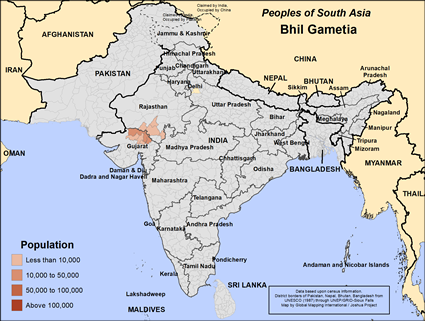Bhil Gametia in India

Send Joshua Project a photo
of this people group. |

Map Source:
People Group data: Omid. Map geography: UNESCO / GMI. Map Design: Joshua Project
|
| People Name: | Bhil Gametia |
| Country: | India |
| 10/40 Window: | Yes |
| Population: | 59,000 |
| World Population: | 59,000 |
| Primary Language: | Gujarati |
| Primary Religion: | Hinduism |
| Christian Adherents: | 0.41 % |
| Evangelicals: | 0.00 % |
| Scripture: | Complete Bible |
| Ministry Resources: | Yes |
| Jesus Film: | Yes |
| Audio Recordings: | Yes |
| People Cluster: | South Asia Tribal - Bhil |
| Affinity Bloc: | South Asian Peoples |
| Progress Level: |
|
Introduction / History
Gametia is one of the Bhil subgroups. They are a Scheduled Caste who live in Rajasthan. They speak Mewari and read and write in Devanagari. Their name, Gametia, refers to a village dweller, harkening back to when they gave up their nomadic ways and became settled farmers.
What Are Their Lives Like?
The Gametia Bhil work as cultivators or as day laborers. Some of them work in stone quarries. They are usually landless. They have a headman for every village to look after them and judge their disagreements. The Gametia Bhil are endogamous, which means they prefer to marry within their community. Their dead are cremated but when their priests die they are buried.
What Are Their Beliefs?
Almost all of the Bhil peoples practice ethnic religions that have been highly influenced by Hinduism. Shiva is considered the supreme god. Ancestor worship (praying to deceased ancestors) is also quite popular. Shamans (priests) are also called upon to offer sacrifices to the many gods and mud idols.
What Are Their Needs?
The Gametia Bhil people need the transforming power of the Holy Spirit so they can experience His spiritual, economic and social blessings offered by Jesus Christ to those who call on His name.
Prayer Points
Pray that their leaders come to Jesus Christ and lead their entire community into a disciple making movement. Pray that God will give them dreams and visions leading them to openness to the person, Jesus Christ. Pray for faithful intercessors and workers.